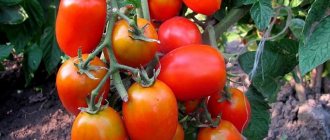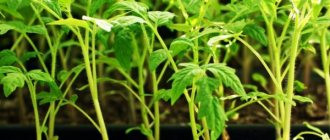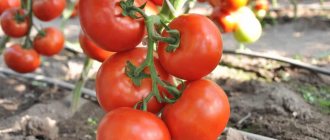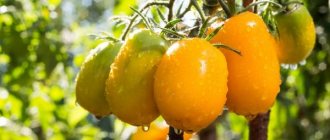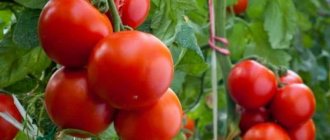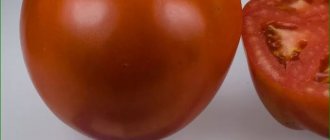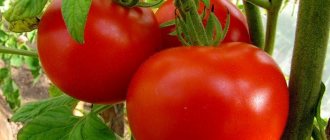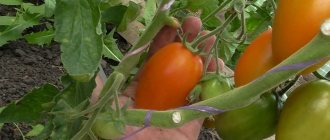Characteristics and description of the variety
Bred in Transnistria, entered into the State Register in 2010.
Determinate bush, height 100-110 cm, medium foliage. The leaves are large, light green. The inflorescences are simple. The first inflorescence is formed above 5-6 leaves, the subsequent ones - after 2 leaves. Each cluster bears 5-7 fruits.
Reference! The term “determinant” comes from the Latin word determination, which means limitation, limit.
An early ripening hybrid, 80–85 days pass from the moment of germination to full maturation. Recommended for cultivation in open ground and in greenhouse conditions.
Productivity is high, from 1 sq. m harvest up to 19 kg of vegetables.
The culture is resistant to the main diseases of the nightshade family, such as late blight, alternaria, fusarium, tobacco mosaic. But it is often attacked by insect pests, such as the Colorado potato beetle.
The plant requires obligatory garter. As the branches grow, they become spreading, so it is better to fix them to a support. In addition, ripe fruits noticeably weigh down the hands, which may not support the weight of the vegetables.
Like gartering, pinching is an obligatory step in crop care.
The fruits are even, smooth, round in shape, the color of ripe raspberries. Weight up to 120 g, thin skin, 4-6 seed chambers. The taste is excellent, a harmonious combination of sugar and sourness. The pulp is medium dense, moderately juicy.
Ripe vegetables cannot be stored for long-term storage. If transportation is planned over long distances, then it is best to transport them unripe.
The variety belongs to the salad variety, so fresh use is preferable. They make amazing summer salads, an excellent base for hot and vegetable dishes, baking vegetables with meat - all these dishes exhibit excellent taste. In pickles and marinades, tomatoes of this variety show their taste less expressively, so they are practically not used for winter preparations.
Planting seedlings in a permanent place
Seedlings are planted 2 months after sowing. Normally, the planting time for the garden falls from mid-May to June. The indicator of readiness for transplantation is 4–5 leaves per stem.
Find out how and when to plant tomatoes in open ground.
Plant seedlings using the following technology:
- Dig holes according to the pattern 0.4 × 0.7 m.
- Pour 200 ml of ash into each hole.
- Pour water into all holes.
- Moisten the soil in the seedling containers.
- Carefully remove the seedlings.
- Place the seedlings in the holes.
- Fill the planting holes with soil.
How to grow seedlings
Sowing of seeds begins 2 months before planting seedlings in the ground. The soil mixture is prepared from garden soil mixed with peat and river sand. All components are thoroughly mixed. To destroy pathogenic microflora, the soil is disinfected with a hot solution of potassium permanganate.
You can plant seeds in a common wooden box or in individual containers: plastic and peat pots. Before sowing, lightly moisten the soil with a spray bottle. Seeds are planted at a depth of 1.5 cm with a distance of 2 cm from each other. After sowing, the containers are covered with glass or film and left in a warm and bright room at an air temperature of at least 23 ° C.
When the first shoots appear, the seedlings are moved to a more illuminated place, for example, on a windowsill. Daylight hours should be at least 14 hours long. If there is not enough natural light, then they are illuminated with ordinary lamps.
When 2 true leaves appear, the seedlings dive, planting them in separate containers. If the grains are sown in individual plastic cups, the sprouts are transplanted into larger containers.
Water as the top layer of soil dries out. Water moderately with warm, settled water. After watering, loosening is carried out with a wooden stick - superficially, so as not to disturb the root system.
After 2 weeks, make the first fertilizing with nitrophoska. If the sprouts develop poorly, they are additionally fed with sodium humate.
2 weeks before planting the seedlings in the ground, the seedlings begin to harden. They are taken outside for several hours, and the night temperature, where the seedlings remain until the morning, is reduced to 13 °C.
Features of agricultural technology of tomato F1 Pink miracle
As already mentioned above, hybrids are unpretentious, but in order to get a good harvest, you need to follow all the rules of agricultural technology and know certain subtleties.
If the packages with seeds indicate that they do not require pre-sowing treatment, then such material does not require any preparatory procedures. If there is no inscription, then you must first carry out disinfection, treatment in a nutrient solution, hardening and other measures:
- disinfection: soaking for 15-20 minutes in a solution of potassium permanganate (1 g of potassium permanganate per 100 ml of water), then the seeds must be washed;
- soaking in an ash solution (take 1 tablespoon of wood ash per 1 liter of water);
- germination in damp tissue;
- sowing.
Picking is a mandatory technique, and to prevent seedlings from overgrowing, experts advise replanting them twice. True, many gardeners quite successfully do the picking once, when the plants have three true leaves.
The second pick can be carried out 18-21 days after the first.
After picking, count ten days and carry out the first feeding of tomatoes. For the first feeding, it is good to use complex fertilizers, combining the procedure with watering. Further care is traditional, as with varietal tomatoes.
Planting in a greenhouse or open ground is planned based on weather conditions and climatic characteristics of the region. The optimal dates are May and early June, but it all depends on the specific situation. The beds are prepared in advance, disinfected, and holes are made.
When growing in greenhouses, the best option is to use trellises for garter. In open ground you can use stakes. They are usually formed into two stems, removing all the shoots, as well as the lower leaves. It is imperative to check the flowers in the clusters, removing all deformed and poor-quality ovaries.
The first feeding in a permanent place is usually carried out 21 days after planting the seedlings. But this recommendation should not be taken too literally, and if you see that your tomatoes are growing slowly and weak, then apply the necessary fertilizer.
The hybrid Pink Miracle is resistant to Alternaria, tobacco mosaic viruses, late blight, and other diseases, but you should not forget about prevention.
An excellent result is obtained by spraying plants with an infusion of garlic, to which potassium permanganate has been added.
Ingredients: 1 liter of warm water, 50 grams of crushed garlic, a little potassium permanganate (so that the solution becomes slightly pink). Let it sit, then spray the tomatoes. It is recommended to carry out such spraying every two weeks.
Instead of this infusion, you can use a composition with iodine and milk (0 liters of water, 1 liter of skim milk, 10 drops of iodine). Also used for spraying. Such measures make it possible to protect tomatoes from diseases without resorting to chemicals.
How to grow tomatoes
After 2 months, the seedlings are ready to be transplanted to a permanent location. The land for planting is prepared in advance, in the fall, by feeding it with organic fertilizers. Then the soil is dug up and all weeds are removed.
Planting pattern: 70 cm - distance between seedlings, 40 cm - between rows. Half a glass of wood ash and a pinch of potassium fertilizer are added to the prepared holes and filled with water. After planting, the seedlings are watered again, the soil is loosened, hilled and mulched. Loosening provides better access of oxygen to the roots, and mulching retains moisture in the beds, so the bushes are watered less often.
Regular watering is established as the sprouts take root in a new place, but not more than 2 times a week. Water moderately with warm, settled water, strictly at the root. After each watering, the soil is loosened, removing weeds with roots.
The crop is fed with organic matter twice per season. This is quite enough to improve the growth and development of the plant during the ripening period. Dilute mullein with water 1:10 or chicken manure 1:15, leave for a week, and then pour 1 liter under each plant.
Pruning is carried out to avoid excess green mass. Density leads to the development of fungal diseases, lack of sunlight, and with a large amount of greenery, it is easy to miss pests, which will lead to their successful reproduction.
If you remove excess shoots from the main stem in time, nutrients are spent on the formation of fruits, and not on the growth of unnecessary green mass. The plant is formed into 2-3 stems.
Gartering of tall bushes is required. Bushes are tied up at an early age to form a strong and even stem. The branches are also fixed to the supports, otherwise they will not support the weight of ripe fruits. A support is installed next to each bush when planting. These can be wooden stakes or metal rods.
Reference! Tomatoes cannot be planted in soil where crops of the nightshade family previously grew. This is due to the fact that they pull the same nutrients from the ground: the tomato crop will not receive enough minerals and vitamins necessary for growth and development. In addition, the likelihood of developing diseases common to nightshades increases.
Diseases and pests
Hybrid crops are characterized by increased immunity to major diseases, and the Pink Miracle f1 tomato is no exception. The main pest of vegetable crops is the Colorado potato beetle. Female beetles lay eggs on the inside of leaves, so it is important to inspect the undersides of leaves.
This pest is collected by hand and burned together with the larvae in glass jars. The beetle eats the leaves of plants of the nightshade family, which leads to their wilting. If the parasite is found in the garden beds, all crops need to be inspected, not just tomatoes.
Slugs also cause damage to tomatoes. To prevent their invasion, the beds are sprinkled with tobacco dust. Slugs are attracted to the smell of beer, and experienced gardeners set up beer traps in their gardens.
The culture does not like high humidity and rainy weather. During the wet season, they are treated with fungicidal and biological preparations. This prevents the development of fungal diseases such as late blight, various rot and mold.
Recommended for fresh consumption
Variety Pink Miracle - features of agricultural technology:
| Seedling Peculiarities:
| |
| Planting care Peculiarities:
| |
| Watering frequency Peculiarities:
| |
| Top dressing Peculiarities:
|
The nuances of growing in open ground and in a greenhouse
In the southern regions, the variety is grown in open ground; in cold regions it is recommended to grow it in heated greenhouses.
Greenhouse fruits ripen earlier than in open beds. Outdoors, the ripening of vegetables is influenced by:
- temperature;
- number of sunny days;
- amount of precipitation.
The height of greenhouse plants is slightly higher than those planted in open ground. To limit growth, pinching the crown is carried out.
In the greenhouse, not only does the fruit ripen faster, but the quantitative indicator is also higher. However, greenhouse plants are more susceptible to fungal diseases and spider mite attacks. Therefore, it is necessary to regularly ventilate indoor structures to keep plants healthy throughout the season.
If the crop is planted in regions with a temperate climate in open beds, it is necessary to have some kind of covering material on hand to protect it in case of unexpected cold weather or heavy rains.
Diseases and pests
Although this tomato variety is resistant to late blight, it can be affected by dry brown spot, brown spot or blossom end rot. To prevent the occurrence of dry brown spotting, which is characterized by the appearance of brown spots on the ground part of the bushes, it is recommended to cover the plants with agrofibre at night.
Top rot usually attacks unripe fruits, manifesting itself in rotting of their tops. Adding one tablespoon of calcium nitrate and a handful of wood ash to the holes during planting seedlings can save you from this scourge. You can spray green fruits with a solution of calcium nitrate. If brown spots, covered with a gray velvety coating, appear on the underside of the tomato leaves, this means that your tomatoes have been attacked by brown spot. You can get rid of it by spraying plants with a solution of copper sulfate.
The most common pests that can attack tomatoes of the “Raspberry Miracle” variety are: tomato moth; whitefly; spider mite; root-knot nematode; plant aphids. Treatment of plants with special biochemical preparations will help get rid of them.
The Raspberry Miracle tomato can rightfully be called a real achievement of Russian breeders.
Harvesting and application
The ripening of vegetables begins in June, the fruits ripen together, which makes them easier to harvest.
Tomatoes can be picked unripe; they are quite capable of gaining color on their own, without losing their taste.
The tomato variety belongs to the salad variety, therefore, first of all, they are used fresh. Tomatoes are good in any salad, and they complement other vegetables perfectly. They are used to prepare hot and vegetable dishes, and are used in baking with meat.
This type is not suitable for pickling and marinades, but it can be used to make tomato products, for example, juice or paste. True, the color of tomato juice will be paler. For rich color, pink tomatoes are mixed with red ones.
Ripe vegetables cannot be stored for long periods of time. They are either eaten immediately or made into canned salads.
The difference between these tomatoes is their high yield of marketable mass. Vegetables are transported over short distances with the possibility of quick sale.
Tomato care
A small number of seedlings are planted for personal use. In this case, it is advisable to immediately plant each germinated seed in a separate container - this way the seedlings are less injured. The seed placement depth is 1.0 – 1.5 cm.
After the first true leaves appear, the seedlings should be fed with potassium humate; repeated feeding is done after 2-3 weeks with nitroammophos.
We invite you to read: Detailed description of the cabbage variety Rinda
Water moderately as the surface layer dries.
When growing seedlings, it is very important to provide them with sufficient light for at least 10 hours a day. For this, both conventional fluorescent and special phytolamps are used.
The temperature for growing seedlings to the level of 4-5 true leaves should be 20-23 degrees, then the seedlings should be hardened, reducing the daytime temperature to 18-21 degrees, and the night temperature to 15-18 degrees. This regime will protect the seedlings from overgrowing.
It consists of regular watering, weeding and loosening. Pink tomatoes are very sensitive to sudden changes in humidity: due to the thin skin, the fruits can burst. Therefore, watering should be regular, in small portions, strictly at the root of the plant.
Feeding is carried out 3 times per season:
- before flowering - complete fertilizer (NPK);
- before fruit set - NPK with a predominance of potassium;
- 2 weeks before harvesting fruits - potassium-phosphorus fertilizers.
Tomatoes are very responsive to foliar fertilizers with superphosphate.
Seeds are sown in March-April. Prepare the soil and pour it into a wooden or cardboard box. Seeds are planted in the ground to a depth of no more than 2 cm.
During growth, the seeds are periodically fed and watered. It is important to ensure a comfortable temperature range, ranging from 20 to 24 degrees.
Diving is done after the second true leaf appears on the tomato. Two weeks after diving, the tomatoes are fertilized again.
A week before planting in the ground, the box with sprouted seeds is taken out into the air for a while to prepare the seeds for transplanting into open ground.
You need to water once a week; if the seedlings begin to dry out, water once every three days.
Tomatoes are planted in greenhouses in April.
The southern regions, when growing the “Pink Miracle f1” tomato, reviews (photos) indicate that they can afford to sow seeds under temporary shelters, bypassing the seedling stage. In this case, the product will turn out a little later, but the small investment will pay off.
For the northern regions, growing seedlings is a necessity. It must be sown 55 - 60 days before the expected date of planting in open ground.
Tomato seedlings of this variety do not require more sophisticated conditions. Timely picking, watering, and fertilizing will be the key to a favorable “nursery” period.
Tomatoes Pink miracle f1 are undemanding to care, but to achieve the characteristics stated in the description, they require compliance with basic agrotechnical rules. To achieve high yields, the following procedures are necessary:
- garter and stepson;
- moderate watering;
- regular proper feeding.
When planting seedlings, a strong vertical support is installed near each bush. Wooden stakes, straight branches of medium thickness, and special metal-plastic supports are used as support. As the tomatoes grow, they attach central stems and branches that require support.
To improve growth and to prevent the fruits from becoming smaller, the bushes are formed into 3 stems. For this, 2 well-developed lower stepsons are left, the rest are removed. Every 2 weeks, check the tomatoes and remove growing shoots.
Plants need regular watering
The variety requires regular watering due to the structural features of the roots. The plant does not tolerate drought well. In case of insufficient watering:
- the process of photosynthesis slows down;
- nutrients are supplied in insufficient quantities;
- metabolism slows down
As a result, the leaves turn yellow and begin to shed flowers and ovaries, and the fruits do not develop.
Water the bushes with warm, settled water in the evening. Watering is carried out at the root.
Top dressing
Tomatoes are fertilized three times in different phases of development, during the period of active growth of the bush, at the beginning of mass flowering and when fruiting begins.
- For active growth of stems and leaves, fertilize with nitrogen-containing fertilizers. Urea or bird droppings are suitable for this.
- To improve flowering, use phosphorus-potassium fertilizer (superphosphate, bone meal).
- For the development of fruits, they take more potassium; they practice the use of potassium mag, potassium humate or ash solution.
To stimulate fruit set in tomatoes, you can use “Boroplus”, “Ovary”, and a solution of boric acid.
Advantages and disadvantages of the variety
Early-ripening raspberry-colored tomatoes are always in demand on the market, despite the fact that they are practically unsuitable for winter harvesting. However, they are so fortified that they help improve immunity. In addition, they are ideal for those who cannot eat red vegetables due to allergies.
Advantages of the variety:
- ease of care;
- early maturing hybrid;
- high fruiting rate;
- resistance to major diseases;
- excellent taste of fruits;
- high content of vitamins;
- attractive presentation;
- high consumer demand;
- Possibility of breeding for sale.
Among the disadvantages of this culture, several factors are noted:
- Garter required;
- stepsoning required;
- inability to independently select seeds for the next planting;
- short shelf life;
- limited scope of application on the farm.
Description of the fruit “miracle”
Raspberry-pink tomatoes with an average weight of 100 g, at first glance they do not look anything special. Even, neat, smooth, in an unripe state they have a light green color. During the ripening period, the spot on the stalk is clearly visible. It’s a little scary for novice vegetable growers; it’s been present on tomatoes for too long. However, gradual ripening reduces the greenness and it disappears completely.
The tomatoes are medium firm to the touch. Quite pleasant in smell, they cause delight because they are the first to arrive at the table.
An additional bonus is the amazing taste. Salad, early production is the most desirable and if it is also pleasant, then such a tomato should be in the gold reserve of every gardener.
The author of the variety, unfortunately, did not bother to conduct a biochemical study of tomato products for the content of dry substances and sugars, but the “Excellent” rating for tasting qualities indicates that the balance of substances responsible for the sweet-sour aftertaste is fully respected.
Gardeners from different regions note the different taste of tomatoes, and this is not surprising. Having absorbed the warmth of the sun's rays, the tomato fruit synthesized a fair amount of sugar, but in more northern regions, the tomato is less sweet, but just as tasty and desirable. The smell of tomato is also interesting; it tends to change. A tomato at the initial stage of ripeness has its own aroma, quite pleasant, but not so intrusive, but when thoroughly ripe it emits a very interesting, sweet smell.
Tomato behaves well in processing. Having selected fruits in the range of 70 - 80 g, they can easily be placed in tanks for preservation or pickling. Tomatoes also behave well when quickly fermented in barrels. The fruits do not crack, their flesh remains elastic, and the taste completely satisfies lovers of such products.
Tomato pastes, sauces and juices from the fruits of this tomato have a high dry matter content, which makes them quite full, dense and does not require strong boiling.
Farmer reviews
The opinion about the hybrid is equally positive both among entrepreneurs who are engaged in breeding any crop on an industrial scale, and among ordinary summer residents - amateurs who want to pamper themselves with unusual tomatoes:
Tatiana, Balakovo: “I grew the Macedonian pink miracle for the first time. At first the tomato was under cover, and then the film was removed. I was not sick, the ripening progressed smoothly, the fruits were sweet and soft. I liked it"
Valentina, Nizhny Novgorod region: “I grew it in a greenhouse. The bush led into 1 trunk, grew short, but prolific. There are 3-4 tomatoes on the branches, the weight reached up to 150 g. Very tasty.”
Vera, Krasnodar Territory: “My favorite tomato. Grows quickly. The fruits are not large, but aromatic. They sell well and are among the first to ripen.”
Productivity features
Tomato “Pink Miracle” reviews, photos, yield - everything is cute to contemplate. The yield of a variety can be assumed even from the appearance of the plant itself. The yield of a bush completely covered with tomatoes cannot be low.
The author of the variety indicates rather modest figures of 2.5 - 3 kg per sq. m., which is not enough for a hybrid. However, given that this tomato is very early, and its products are tasty and have a high market price, even such a harvest is justified.
Gardeners report much larger harvests. Indicator 10 - 12 kg per sq. m. is quite realistic if you follow the agricultural techniques for growing tomatoes. When planted in greenhouses and greenhouses, the yield is much higher, and the plant is formed without cutting back too much, which allows for a larger volume of tomato products to be produced.
Recommendations
The mid-season, low-growing tomato variety Yaki F1, reviews of which are associated with high yields and the ability to be cultivated in open ground, is intended for industrial production. The hybrid is popular among vegetable growers.
“Last year, neighbors praised the Yaki hybrid. I decided to try growing it in the garden. I didn’t tie up the tomatoes; they grew spread out. It seemed as if someone had strewn the red layer of fruit. The tomatoes are dense, with amazing taste. They marinate well, and the prepared puree retains the aroma of fresh tomatoes.”
“I have long been interested in growing low-growing varieties of tomatoes, so the Yaki hybrid attracted my attention. High yield is guaranteed with proper care
To do this, you need to prepare the soil and apply organic and complex fertilizers. The result is as in the photo with seeds. Abundant harvest of oval-shaped tomatoes.”
Since the “Pink Miracle” variety is a hybrid (as evidenced by the F1 mark on the packaging with seed), harvesting seeds from tomatoes grown in your own garden does not guarantee a repeat of an equally excellent harvest next year, since the most valuable qualities obtained by the hybrid are from “ parents” are not always inherited.
Therefore, it is better to purchase new seeds from a specialized store.
When doing this, you need to pay attention to the expiration date indicated on the packaging and its integrity.
You can eat such fruits by simply cutting them into pieces and sprinkling them with herbs, or adding them to salads. Due to the impressive size of the fruit, it is often enough to take just a couple of these tomatoes for lunch and dinner - this will be enough to prepare a full-fledged vegetable dish. They also make excellent tomato juice.
“Pink Miracle” tomatoes are almost never used for canning due to their large size, although some connoisseurs of this particular variety cut these tomatoes into pieces before pickling and prepare them in this form. It’s simply inconvenient to put them whole in a jar, which is the reason for consuming them mainly raw. Small specimens can be added to containers when pickling tomatoes of other varieties.
For more information about pink tomatoes, see the video below.
Agrotechnics of cultivation
The best predecessors for growing a hybrid are winter grain crops, annual legumes, cucumbers, and cabbage. When choosing a method of growing in a permanent place without preliminary cultivation of seedlings, it is necessary that the soil warms up to 12 °C at a depth of 5-6 cm.
Sowing seeds for seedlings is carried out in mid-March. To do this, seeds are placed in special containers with prepared and moistened soil, covered with a layer of soil and film until the sprouts hatch.
Planting material is transferred to open ground after the end of the spring frost period. The recommended plant density depends on the cultivation conditions and varies from 2 to 7 bushes per 1 m².
When using the technology for obtaining a tomato harvest in open ground in the second rotation after early crops (onions, cabbage, potatoes), 35-45-day-old seedlings are planted at the end of June. The harvest takes place at the end of September.
The productivity of the variety per 1 m² is 10-12 kg. To obtain the maximum yield, before planting, it is necessary to add 40-50 kg of organic fertilizers and 700 g of Nitroammofoska per 10 m² to the soil.
Most of the substances are applied in the fall, and the rest in the form of periodic fertilizing during the growing season. By the beginning of fruit ripening, to improve their quality, additionally use potassium (200 g) and ammonium nitrate (100 g) per 10 m².
During the growing season, 5-10 waterings are carried out using the drip irrigation method, which allows maintaining the balance of moisture and air near the root system. It is recommended to apply soluble mineral fertilizers with each watering.
Biological pests of tomato are the Colorado potato beetle, aphids, and cutworms. When using the seedling cultivation method, the plant is treated in solutions of special preparations before planting in the ground.
The most harmful diseases of the crop are late blight and black bacterial spot of tomatoes. In some years, the plant may be affected by stolbur. Elimination of disease carriers (leafhoppers) is carried out using insecticides.
The variety, like most representatives of the nightshade family, prefers the seedling method of planting. Preparatory work should begin in mid-spring. To obtain healthy seedlings you should:
- Plant the seeds to a depth of 1-2 centimeters;
- Cover the planting with film to allow sprouts to appear;
- Spray with water from a spray bottle;
- Ensure the room temperature is not lower than plus 21 degrees;
- When seedlings appear, transplant them into separate containers;
- Provide plants with lighting for at least 16 hours a day;
- Regular watering.
As we said earlier, the tomato is very unpretentious. Sowing begins in mid-March and continues until early April. To get quick shoots and a good harvest, you need to look at the lunar calendar. The moon in different phases affects all living things on our planet and especially plants. If you don’t want to do this, but are guided by the rule, there is time, it’s time to do things, then just remember this simple advice.
So, you sow in boxes or separate pots, for which peat cups are great. Next, moisten and cover with glass or film. After 5-7 days, shoots will appear. Now they need light and watering. You can buy soil for crops at any store. You can simply take garden soil and mix it with universal soil or humus.
Advice!
You don’t have to do any pre-sowing treatment or use growth stimulants, because the variety is quite resistant. But if you are used to soaking seeds, then please, prevention is always good.
Planting outside is carried out after all frosts, and in a greenhouse at the beginning of May or even at the end of April. Further, care is quite simple. You remove stepchildren about once a week. The bushes need to be formed, but it is very simple. To get two stems, leave one stalk at the top to make three, two on both sides in the axils at the top. Remember about the supports in advance so that the bushes do not suffer from their own tomatoes.
You can prepare the soil in a greenhouse or outside - pour boiling water over it, add a spoonful of mineral fertilizer to each hole. In general, this tomato will only need 2-3 feedings per season. You can take a complex preparation, but it is better to take biological agents so that the fruits are environmentally friendly.
Of course, you should remember about basic agricultural technology - loosening the soil after watering, removing weeds on time, regularly ventilating the greenhouse if you grow crops in an enclosed space. These simple measures help seedlings to grow well, develop, and ripen quickly. In addition, dense plantings and the presence of weeds contribute to the development of pathogenic flora, and no matter what variety is resistant, in poor conditions it can begin to suffer or reduce yields.
